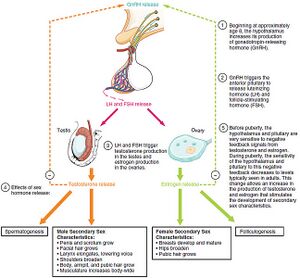Physiological Changes in Girls During Puberty
Original Editor - User Name
Top Contributors - Khloud Shreif and Kirenga Bamurange Liliane
Introduction[edit | edit source]
Puberty is a normal, vital, physiological process including a series of normal hormonal changes resulting in changes in gonads (testosterone, aldosterone, and progesterone) and reproductive organs to be functionally mature, resulting in the physical development of sexually mature adults, it is a transition stage between the childhood and adulthood period happens in all normal individuals. This process undergoes different factors; hormonal, genetic, environmental, or even nutritional factors.
In African America, it begins around the age of 6, and in white girls starts between 8 and 13 years of age. It is considered the spurt of puberty that occurs between 9 and 10 years old.
Physiology Of Puberty[edit | edit source]
The first changes of puberty are initiated by pulsatile secretion of Gonadotropin-Releasing Hormone (GnRH) neurons of the hypothalamus. GnRH is transported to the anterior pituitary gland (pituitary gonadotropes) resulting in the synthesis and release of LH and FSH from the gonadotropic cells of the anterior pituitary gland these hormones affect theca and granulosa cells of the ovary in females and affect the Leydig and Sertoli cells in the testes. This is considered the spurt of physical puberty in individuals[1]. The level of circulating LH is much greater than FSH in boys and girls from early pre-puberty to pubertal onset[2].
Then when LH and FSH bind to their receptors in ovaries and testes they stimulate them to release (estrogen, aldosterone, and a small amount of testosterone in females). FSH increases estrogen production from the ovaries, and LH helps to start the ovulation and creation of the corpus luteum in girls. While in boys FSH triggers testicular growth and supports spermatozoa maturation, and LH increases testosterone production[3].
Secretion of Growth Hormone (GH) from the pituitary gland helps to keep the linear progress of puberty.
Physiological Signs and Symptoms[edit | edit source]
Pathophysiology[edit | edit source]
Premature puberty: it starts before the age of 7 or 8 in girls, and before 9 in boys.
Delayed puberty
It is a lack of physical signs of puberty about 2 to 2.5, in boys it can reach to be about 4 years. In girls, the absence of breast development by 13 years or more than 4 years between (thelarche ) and menarche is considered delayed puberty.
Resources[edit | edit source]
References[edit | edit source]
- ↑ Herbison AE. Control of puberty onset and fertility by gonadotropin-releasing hormone neurons. Nat Rev Endocrinol. 2016 Aug;12(8):452-66.
- ↑ Mitamura R, Yano K, Suzuki N, Ito Y, Makita Y, Okuno A. Diurnal rhythms of luteinizing hormone, follicle-stimulating hormone, testosterone, and estradiol secretion before the onset of female puberty in short children. The Journal of Clinical Endocrinology & Metabolism. 2000 Mar 1;85(3):1074-80.
- ↑ Alotaibi MF. Physiology of puberty in boys and girls and pathological disorders affecting its onset. Journal of adolescence. 2019 Feb 1;71:63-71.







